Microsoft’s new Z-code models, which use a ‘Mixture of Experts’ approach, are meant to make Translator and other Microsoft AI services perform better and be more efficient to run.
Microsoft is updating its Translator and other Azure AI services with a set of AI models called Z-code, officials announced on March 22. These updates will improve the quality of machine translations, as well as help these services support more than just the most common languages that have less available training data.
The new Z-code models use a sparse “Mixture of Experts” approach, which Microsoft execs described as being more efficient to run because it only needs to engage a portion of the model to complete a task. The result, according to Microsoft: Massive scale in the number of model parameters while keeping the amount of compute constant.
Microsoft recently deployed Z-code models to improve common language-understanding tasks like name entity recognition, text summarization, custom text classification and key phrase extraction across its various Azure AI services. But today’s development marks “the first time a company has publicly demonstrated that it can use this new class of Mixture of Experts models to power machine translation products.”
Z-code is part of Microsoft’s larger XYZ-code project which seeks to combine models for text, vision, audio and multiple languages to create more powerful and integrated AI systems that can better speak, hear, see and understand. The Z-code models fall under the Microsoft AI at Scale and Turing initiatives which are seeking to develop large models that are pretrained using large amounts of textual data and which can be integrated directly into Microsoft and customer-developed products

